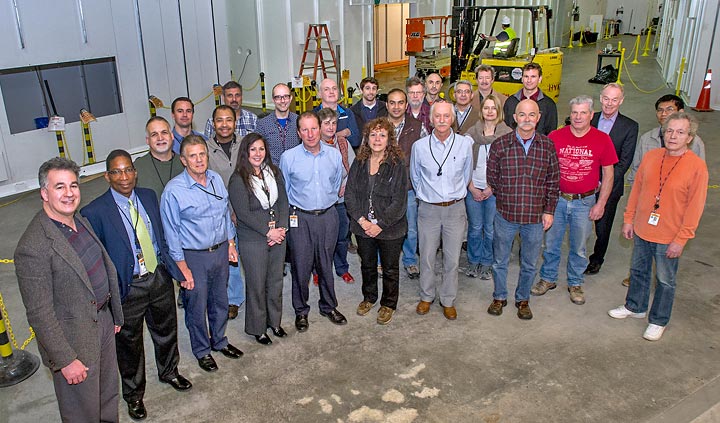Make Way for ABBIX
March 26, 2014
Enter the experimental floor of the National Synchrotron Light Source II (NSLS-II) and you’ll find an obstacle course. Around and across the half-mile circular floor are hutches jutting out for the NSLS-II “project” beamlines, cage after cage housing workbenches and tools, and parts along the inner and outer perimeters waiting for installation. Now come the three ABBIX beamlines.
“It’s full speed ahead for ABBIX,” said project manager Lonny Berman, physicist with the Photon Sciences Directorate.
ABBIX is an acronym for Advanced Beamlines for Biological Investigations with X-rays. The National Institutes of Health (NIH) is supporting the construction of these beamlines with $45 million, supplemented by $3 million from the NSLS-II construction budget, money that came from the Department of Energy (DOE).
Some recent and projected dates: ABBIX was baselined in April 2013, which set the budget and schedule. The final design report was approved in November 2013. Now is a period of procurement and installation of accelerator and beamline components. According to Berman, early project completion is expected by the end of calendar year 2015, with project closeout scheduled for June 2016.
ABBIX consists of three beamlines:
- AMX (Flexible Access and Automated Macromolecular Crystallography)
- FMX (Frontier Macromolecular Crystallography)
- LiX (High-brightness X-ray Scattering for Life Sciences)
Dieter Schneider, beamline group leader for both AMX and FMX, explained that the new crystallography beamlines will provide structural biologists with a pair of uniquely powerful beamlines for the efficient structure determination and functional studies of biomedically important macromolecules ranging in complexity from enzymes to large molecular assemblies with organelle-like functions.
“Particularly valuable will be FMX’s micron-sized beams for wringing structures from large numbers of even the smallest crystals of membrane proteins, notorious for their fragility and heterogeneity when grown large,” said Schneider. “AMX – with a very high flux, short data collection times of just seconds, and automated specimen handling – will make it easy to measure each crystal in a lot of many crystals to obtain high data quality from relational sorting of redundant experiments.” He added that to better connect an investigator’s crystallization lab with NSLS-II and shorten the biochemistry-to-structure process, AMX and FMX will be able to characterize arrays of crystallization trials by diffraction at room temperature.
The LiX beamline is designed to be a versatile instrument capable of multiple modes of operations all dedicated to life science applications, according to Lin Yang, group leader for that beamline. He said, “Compared to existing facilities, LiX will allow researchers to study the structures of biological molecules in their near-native environments much more quickly and at improved time resolution. The beamline’s wide energy range also presents unique opportunities to solve novel membrane structures.”
In addition, Yang noted, researchers can examine the structures of biological tissues using scanning-probe imaging. And although the beamline has to accommodate different types of experiments, “the modular design of the experimental station enables rapid switching between experiments to maximize the utility of the beam time,” said Yang.
Located at roughly 10 o’clock on the NSLS-II circle, the ABBIX beamlines are clustered in two (out of 30) wedges of the experimental floor and labeled 16-ID and 17-ID. (“ID” stands for insertion device, a special multi-magnet device that is “inserted” into a straight arm of the polygonal NSLS-II synchrotron ring to increase the brilliance of the x-ray beam delivered to the beamline.)
Construction of the hutches for LiX started in December 2013, with New Jersey-based Global Partners in Shielding (GPS) assembling steel enclosures in which experiments will be done. That work was substantially completed in March 2014. Now, GPS and the French company Caratelli have started building the steel and lead hutches, respectively, for AMX and FMX.
This activity is taking place along the inside edge of lab-office building 5 (Bldg. 745), where the ABBIX offices are located. Sharing space with the NSLS Macromolecular Crystallography Research Resource, known by the acronym PXRR and supported by NIH and by DOE’s Office of Biological and Environmental Research (BER), and the East Coast Structural Biology Research group, supported by NIH’s National Institute of General Medical Sciences, the ABBIX project is fully integrated in the structural biology program of NSLS-II that is operating beamlines at NSLS until the end of September 2014, when NSLS will shut down.
“These two groups, plus ABBIX and members of the staff of the SRX [NSLS-II] project beamline, have teamed up to request further funding in a joint grant from NIH and DOE BER for the future operation of these and other life-science beamlines at NSLS-II,” said Bob Sweet, structural biologist in Photon Sciences. Sweet is principal investigator for PXRR and is leading the effort to win the new NIH/DOE grant. “The three ABBIX beamlines will be the first devoted to life sciences at NSLS-II,” he said, adding that several NSLS-II project beamlines have the capability to do some types of imaging and may host the first life science experiments performed at the new facility in the coming year.
In the years leading up to NSLS-II construction, NIH evaluated the needs of the life sciences user community, with input from special advisory panels. ABBIX beamlines will address the needs of this community by providing small intense beams to improve sensitivity of crystal structure determination, critical for tiny crystals of proteins that are difficult to crystallize, particularly membrane proteins. And using such small beams, scientists will also gain unique insight into questions about the structure and behavior of macromolecules and macromolecular assemblies in solution, at time scales as short as 10 microseconds.
2014-4746 | INT/EXT | Newsroom










